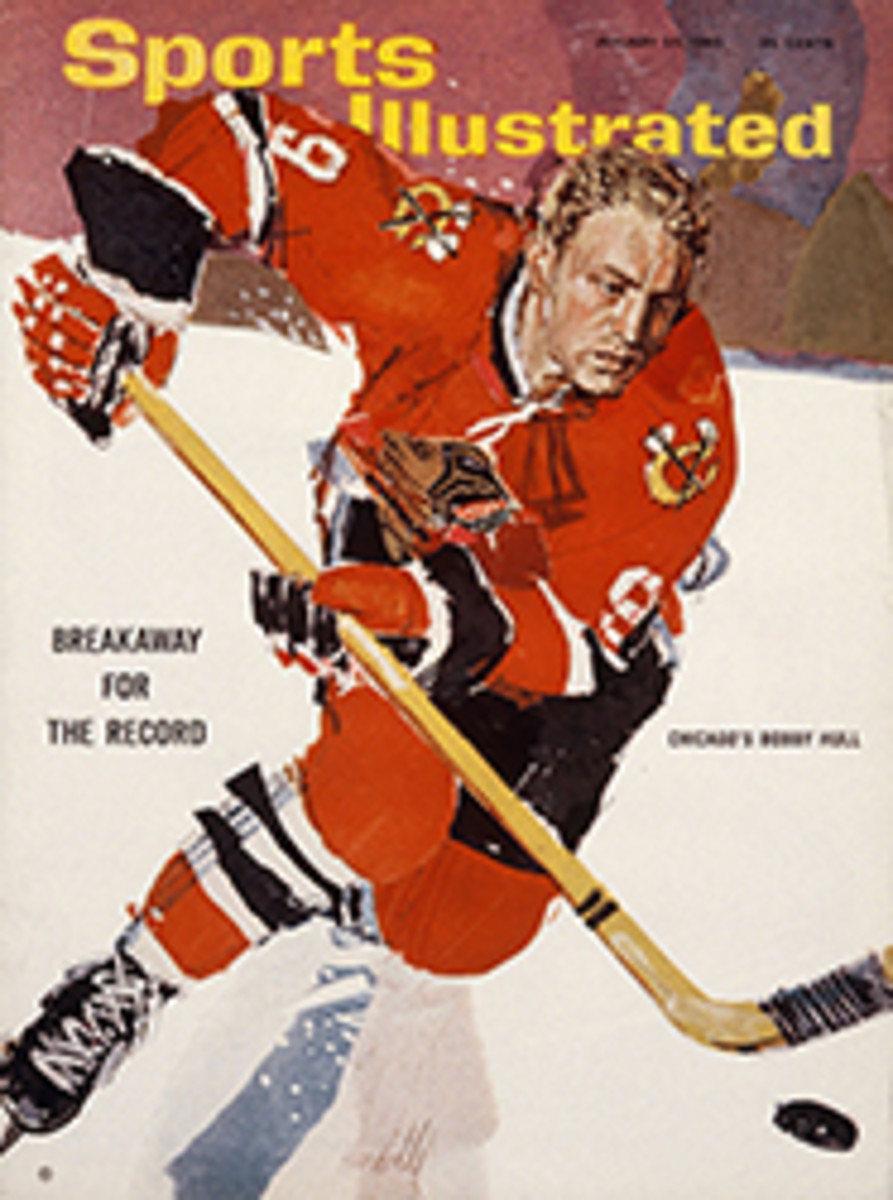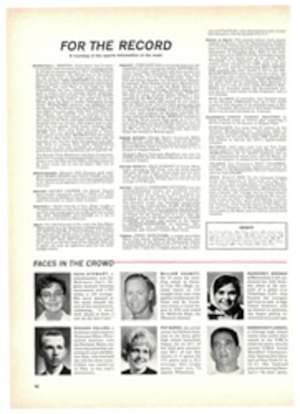
ANOTHER BIG BLUFF BY BIG WILT
At midpoint the pro basketball season has a familiar look: the Celtics are running away from the rest of the league, the East won the All-Star game and Wilt Chamberlain is threatening to quit. The Celtics' surge and the East's victory, though expectable, at least have been exciting to watch. The petulant moods of Wilt the Stilt are getting to be a bore.
Chamberlain is one of the genuine superathletes of his generation. He could have been a first-rank shotputter, high jumper or quarter-miler, but he chose to abandon those events before discovering his own limits. And he has never discovered—or shown anyone else—how good he can be in basketball.
Chamberlain has quit or threatened to quit five times: as a sophomore and as a junior at Kansas, after his first year as a pro, when his team moved from Philadelphia to San Francisco and last week when he was traded from San Francisco back to Philadelphia. The threat has nearly always been used by Wilt as an instrument to bargain for more money, and he has consistently gotten away with the bluff. If the NBA had called his hand when he said he was quitting—for silly reasons—after his first year it might have turned Chamberlain into a full-time athlete instead of a part-time financier, into an athlete far more amenable to coaching and to the demands of team play. At that time Wilt would not have quit; he did not have the money to quit, and he had no other means of earning real money. Instead he got his way, and he has continued, in basketball, to do only the things that come easy to him because of his talent That talent is remarkable, but it remains only partially developed. Indeed, Chamberlain has hardly improved over the player he was in high school. Asked once (at Kansas) why he did not practice moves other than dunking the ball or his fallaway jump shot—essentials like foul-shooting, for example—Wilt replied that foul-shooting was not what he was being paid for.
He is now being paid $75,000 a season, and that is one of the important reasons why he has been traded. Wilt was drawing the salary and not the fans, and the Warriors were nearing the end of their period for depreciating Wilt's value for income tax purposes. Worse, the rest of the San Francisco team had suffered by the imposition of Chamberlain's somewhat limited style instead of benefiting from his accommodation to their abilities.
Chamberlain probably is bluffing this time, too. He has invested his NBA money intelligently, but the apartment houses he owns in Los Angeles yield a low immediate return and a nightclub in which he had a financial interest has folded. At the same time, he now considers San Francisco another of his home towns, and he has no intention of giving up his $400-a-month two-bedroom decorator-furnished apartment in fashionable Pacific Heights.
The trade itself is startling on more than one count. It is the most sensational basketball deal ever, but it is also the first time in the history of professional sports that an athlete of Chamberlain's stature has been traded while at the peak of his career. That he was exchanged for less than $50,000 (not the widely reported $300,000) and three guys named Neumann, Shaffer and Dierking whom most people never heard of is also extraordinary. Finally, it was transacted at 12:30 in the morning after the All-Star game in St. Louis by a group of men on the landing of a winding staircase at a party at Stan Musial's restaurant. An NBA referee named Joe Gushue, casually ambling up the stairs to attend a buffet dinner, overheard the conversation. Just as casually, he informed his fellow diners that the most famous basketball player in the world was being traded down there on the stairs.
In 1963, when Alex Hannum took over as coach at San Francisco, he persuaded Wilt and the team that they could play together, still depending a great deal on Wilt but working with him. It worked. Chamberlain scored the least and assisted the most of his career, and the Warriors won the Western Division title. But this year the system has collapsed, and the Warriors are the worst in the league. True, they were hit hard by injuries—but not that hard. "Last year," an NBA official says, "they were all cutting off Wilt and working together. This year nobody moved. Wilt was forced to shoot most of the time, whether he wanted to or not. The whole team has just lost heart. These guys are pros, all right, but their attitude became 'What if we do win a few? Who can make money with this guy on the team? Who gets any kick out of playing with him?' "
So the problem of handling Wilt passes to Philadelphia Coach Dolph Schayes, who has never been a Chamberlain booster but now says manfully that Wilt can lead the team to a title. Schayes and the 76ers' owners are deluding themselves about Wilt's gate appeal. Actually, he is only a one-time attraction, and most people in Philadelphia (his real home town) have seen him already. Besides, as San Francisco found out, Chamberlain is a better draw on the road—he is the big bad guy and people can root against him—and, by one of the NBA's rules to help weaker franchises, the home team keeps all the gate receipts.
The trade should have little effect on this year's standings. San Francisco is just too far behind in the West, and Philadelphia is up against the league's two best teams in the East. Cincinnati is getting an outstanding coaching job from Jack McMahon, Jerry Lucas is much improved offensively and Oscar Robertson has somehow managed to become even better—making the Royals the league's second best team. But Boston is easily the very best.
The power of these two teams was never more evident than in the All-Star game, in which the East won a 124-123 victory. The score is entirely misleading. Using Coach Red Auerbach's Boston offense—which Lucas and Robertson played with many of the Celtics on a State Department tour last spring—the East dominated the game until Baltimore's Gus Johnson led a late rally. Lucas deservedly received the MVP, and if there is anything new to be learned from the game it is that these two young forwards, Lucas and Johnson, may be almost ready to replace two old forwards, Elgin Baylor and Bob Pettit, as the league's best at their position.
In St. Louis, Lucas hit on his first four shots, had missed on only three of nine at the half, and the East was ahead 75-61. Against the West's much taller front line, he had 10 rebounds. After a college career of shooting only when absolutely necessary with a supporting cast of good marksmen, he is finally adjusting to the offensive requirements of pro ball and to playing in a corner much of the time instead of with his back to the basket. Credit for his improvement must go to Robertson's floor generalship as well as to Lucas' own efforts.
A year of growth
The two-day show that St. Louis Owner Ben Kerner put on was a fitting display for a sport that shows attendance increases in most of its cities and whose franchises now command seven-figure fees (Baltimore was sold for $1.1 million last month). Even without the bundle of TV money that NBA owners dream will one day be theirs, to match that of pro football, business is good. The quality of play is superb, and young pros like Willis Reed and Lucious Jackson will be getting better. So will that new center in San Francisco, Nate Thurmond, who already has gotten a pay raise to go with his new job. After all these certainties, there remains the question of how Wilt will do back in familiar Philadelphia. He still has immense pride in his abilities, and Schayes says he will even teach Chamberlain how to shoot fouls. Maybe. In any event, this ought to be the last time for the bluff.
PHOTO
Lucas balances his trophy and tries out his prize after winning performance in St. Louis.
PHOTO
NEIL LEIFER
Masked to protect injured nose, Chamberlain vainly attempts free throw in All-Star game.

